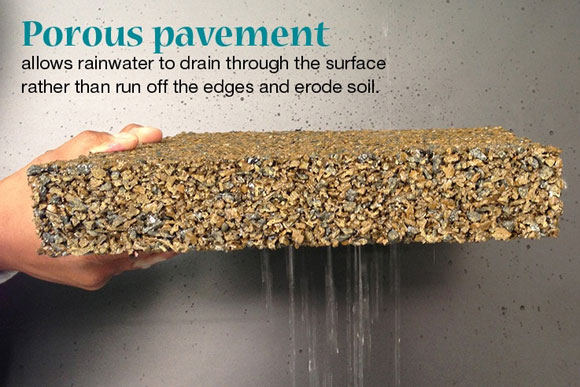An alternative paving material called Flexi-Pave is being piloted by DDOT and appears to be a solution to a long list of infrastructure challenges in D.C., including the age-old war between tree roots and sidewalks.
If you’ve recently visited Rhode Island Avenue NE or Georgetown, you might have done a double take at a few trees whose roots appear to have been paved over.
Despite what it looks like at first glance, the Flexi-Pave material covering the tree boxes just might be the best thing that ever happened to those trees.
DDOT has been experimenting for several years with “using rubberized materials to deal with tree and sidewalk conflicts, where the tree still has a long life ahead of it, but the root system and the sidewalk were no longer compatible for pedestrians, or ADA purposes,” says John Thomas, the Associate Director of the Urban Forest Administration for DDOT. In other words, as trees grow, they often push up the sidewalks, creating a broken mess that is easy to trip over. Keeping the sidewalks safe and usable without repeatedly re-paving often means cutting down a big beautiful tree.
Conventional tree boxes come with quite a few challenges in an urban setting. Thousands of people step on the soil, compacting it so that trees can’t get enough air and water, and storm water can’t drain very well into the ground. Using a tree grate protects the soil, but collects trash and attracts rodents.
Paving over tree roots makes the problem worse, because the rigid bottom surface of the pavement sweats moisture slowly and has a thin layer of air, both of which tree roots are attracted to, so they push up. Tree roots emerging from broken sidewalks create jagged, dangerous sidewalks, especially for people with disabilities.
Dr. Jessica Sanders, Director of Technical Services and Research for Casey Trees, says, ”You might have heard of the term 'tree coffin' which is what some arborists call extremely small tree boxes, because they really don't give the tree enough space and resources to reach its maximum potential for growth. The more soil a tree has access to; the larger it will grow.”
In areas with heavy pedestrian traffic and narrow sidewalks like Georgetown, some trees just don’t survive long—they have to be regularly re-planted. In a handful of tree boxes in Georgetown, and a few strategic problem areas, DDOT is testing Flexi-Pave to see if it will improve some of these problems.
Flexi-Pave is a porous, flexible paving material made from ground-up pieces of recycled tire rubber, small pieces of gravel and (environmentally friendly) materials that help them stick together. The flexible, permeable texture reduces soil compaction, even with people stepping all over it, providing the tree with more air and water and space that allow it to grow to maturity. Flexi-Pave also doesn’t trap trash or debris, so nothing is left to attract rodents. According to the manufacturer, it even filters out phosphates, nitrates and other contaminants.
Almost a year into the pilot program, Flexi-Pave appears to be holding up quite well. Trees are surviving, clean up and concrete maintenance costs are down, and fewer people are tripping over tree roots.

But the material does cost more to install, and some find it ugly. The test areas in Georgetown have played with dyeing the rubber or incorporating pebbles to match the neighborhood’s specific aesthetics.
The benefits for storm water management and related river-pollution issues alone may end up being the most significant benefit. Thomas says, “I went out after a downpour…The concrete next to [the Flexi-Pave] had standing water, puddles, but there wasn’t a drop of water anywhere on the Flexi-Pave.”
With a significant list of problems much improved, and nearly all positive feedback, it seems likely that these pilot programs will continue and expand to more areas. It's still unclear how the material will hold up over very long periods of time, with tree roots continually expanding and shifting.
But the porous pavement has the potential to change D.C.'s treescape. Can tree boxes made of tires create a maturing urban tree canopy that costs less to maintain, make cleaner, less slippery sidewalks, and improve the health of our rivers?
Dr. Sanders says, “With a product that's only been on the market for a very short amount of time, and an urban environment that is very different from a sterile lab, it's difficult to tell. But... a lot of people are hopeful that they can do just that.”